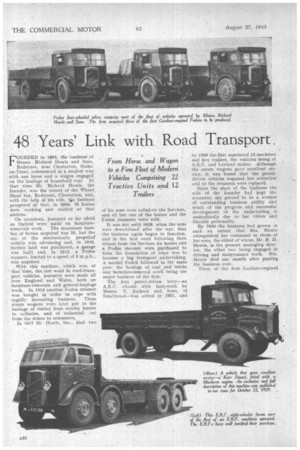48 Years' Link with Road Transport.
Page 24

Page 25

If you've noticed an error in this article please click here to report it so we can fix it.
From Horse and Wagon to a Fine Fleet of Modern Vehicles Comprising 22 Tractive Units and 12 Trailers
FOUNDED in 1895, the business of Messrs Richard Howie and Sons, Redstreet, near Chesterton, Stokeon-Trent, commenced in a modest way with one horse and a wagon engaged on the haulage of household coal At that time Mr. Richard Howie, the founder, was the tenant of the Wheat Sheaf Inn, Redstreet, Chesterton, and, with the help of his wife, tile business
prospered so that, in 1904.. 19 horses were working and stabled ,at that address.
On occasions, journeys as far afield as Oxford were made on furnitureremovals work The maximum number of horses acquired was 25, but the era of the mechanically propelled' vehicle was advancing and, in 1910, further land was purchased, a garage was built and, in 1912, a Foden steamer, limited to a speed of 5 m.p.h., was acquired.
With this machine, which was, at that time, the last word in road-transport vehicles, journeys were made all Over England and Wales, both on furniture-removals and general-haulage work. In 1914 another Foden steamer was bought in order to cope with rapidly increasing business. These steam wagons. were later put to the ' haulage of timber from nearby forests to collieries, and of industrial _oal from the mines to consumers.
In 1917 Mr Howie, Snr., died two of his sons were called-to the Services, and all but one of the horses and the Foden steamers were sold.
It was not until 1919, when the sons were demobilized after the war; that the business again began to function, and in the first week following their release from the'Services six horses and a Foden steamer were purchased to form the foundation of what was to become a big transport undertaking. A second Fodeñ. followed in the same year; the haulage of .coal and bricks and furniture-removal wort; being the major business of the 'firm.
The first petrol-driven lorry—an A.E.C. chassis with bs:),dywork by Messrs S, Jackson and . Sons. of Smallwood—was added in 1921, and
by 1930 the fleet numbered 12 machines and five trailers, the vehicles being of A.E.C, and Leyland makes. Although the steam wagons gave excellent service, it was found that the petroldriven vehicles required less attention and so the steamers. were replaced. • Since the start of the business the wife of the founder had 4ept the accounts; she proved to be a woman of outstanding business ability and much of the progress and successful development of the undertaking is undoubtedly due to her vision and likeable personality.
By 1930 the business had grown such an extent that Mrs. Howie relinquished her command to three, of her sons, the eldest of whom, Mr. R. D. Hnwle, is the present managing director, the other two being engaged in driving and maintenance work. Mrs. Howie died one month after passing the business over.
Three of the first Gardner-engtned Fodens to be produced were purchased in 1932, two or which are still in tilt.; service of the firm. The business continued to expand and, in addition to essential replacements, the years 1936 and 1937 saw further additions to the fleet with the acquisition of an ERA.' eight-wheeler and an E.R.F, four. wheeler, both of which were fitted with Gardner oil engines. These machines continue to give excellent service and have more than justified their purchase.
Another addition, at about the same time, was an oil-engined Albion, a vehicle which ranks high in the estimation of the operators. The same opinion is held of the Albion petroldriven vehicles which have formed part of the fleet since 1930.
The main business of the firm now included the haulage of flour, which was taken: from millers in Liverpool and Birkenhead' to bakeries in the Stoke-on-Trent areas, as well as corn to local farmers, and sanitary.and table earthenware from local pottery manufacturers for shipment to London, Liverpool and Manchester. The lastnamed class of. load calls for considerable. care in packing and handling, ,owing to its fragile character.
The smaller lorries are concerned with this side of the business, which covers journeys 'to all parts of England, whilst roofing . tiles are carried to building sites in the Liverpool, Manchester, Mansfield, Birmingham and Sheffield districts.
The start of the present war found the firm with a fleet of 22 vehicles and 12 trailers, which have been engaged in the transport of all types of machinery, aeroplane components, munitions and other material essential to the war effort.
The firm are staunch believers in good maintenance, and overhauls are carried out at frequent intervals by their own 'maintenance staff. Thorough greasing is carried out weekly' and tyre pressures are checked daily. Every 14 days the brakes on. all vehicles are tested, and after every 2,000 miles running oil sumps, are drained and replenished.
The fleet now comprises the following ramie of machines :—SiX oil-engined E.R.F.s, one of which is an eightwheeler, one Leyland oil-engined sixwheeler and two petrol-engined fourwheelers of the same make, eight Albion four-wheelers, one being an oiler, two Eoden oil-engined four-wheelers, two -Internationals, one Maudslay four.• wheeler and 12 trailers.
Some idea of the extent of the busim;ss 'of the firm may be gathered from the fact that the total annual mileage covered averages 458.000.




















































